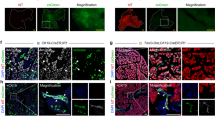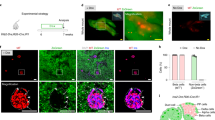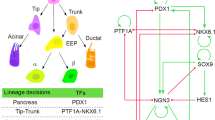Abstract
Pancreas development begins with the formation of buds at specific sites in the embryonic foregut endoderm. We used recombination-based lineage tracing in vivo to show that Ptf1a (also known as PTF1-p48) is expressed at these early stages in the progenitors of pancreatic ducts, exocrine and endocrine cells, rather than being an exocrine-specific gene as previously described. Moreover, inactivation of Ptf1a switches the character of pancreatic progenitors such that their progeny proliferate in and adopt the normal fates of duodenal epithelium, including its stem-cell compartment. Consistent with the proposal that Ptf1a supports the specification of precursors of all three pancreatic cell types, transgene-based expression of Pdx1, a gene essential to pancreas formation, from Ptf1a cis-regulatory sequences restores pancreas tissue to Pdx1-null mice that otherwise lack mature exocrine and endocrine cells because of an early arrest in organogenesis. These experiments provide evidence that Ptf1a expression is specifically connected to the acquisition of pancreatic fate by undifferentiated foregut endoderm.
This is a preview of subscription content, access via your institution
Access options
Subscribe to this journal
Receive 12 print issues and online access
$209.00 per year
only $17.42 per issue
Buy this article
- Purchase on Springer Link
- Instant access to full article PDF
Prices may be subject to local taxes which are calculated during checkout





Similar content being viewed by others
References
Lumelsky, N. et al. Differentiation of embryonic stem cells to insulin-secreting structures similar to pancreatic islets. Science 292, 1389–1394 (2001).
Edlund, H. Developmental biology of the pancreas. Diabetes 50 (Suppl 1), S5–9 (2001).
Kim, S.K. & Hebrok, M. Intercellular signals regulating pancreas development and function. Genes. Dev. 15, 111–127 (2001).
Krapp, A. et al. The p48 DNA-binding subunit of transcription factor PTF1 is a new exocrine pancreas-specific basic helix-loop-helix protein. EMBO J. 15, 4317–4329 (1996).
Adell, T. et al. Role of the basic helix-loop-helix transcription factor p48 in the differentiation phenotype of exocrine pancreas cancer cells. Cell. Growth. Differ. 11, 137–147 (2000).
Rose, S.D., Swift, G.H., Peyton, M.J., Hammer, R.E. & MacDonald, R.J. The role of PTF1-p48 in pancreatic acinar gene expression. J. Biol. Chem. 276, 44018–44026 (2001).
Krapp, A. et al. The bHLH protein PTF1-p48 is essential for the formation of the exocrine and the correct spatial organization of the endocrine pancreas. Genes. Dev. 12, 3752–3763 (1998).
Obata, J. et al. p48 subunit of mouse PTF1 binds to RBP-Jκ/CBF-1, the intracellular mediator of Notch signalling, and is expressed in the neural tube of early stage embryos. Genes. Cells 6, 345–360 (2001).
Li, H. & Edlund, H. Persistent expression of Hlxb9 in the pancreatic epithelium impairs pancreatic development. Dev. Biol. 240, 247–253 (2001).
Herrera, P.L. Adult insulin- and glucagon-producing cells differentiate from two independent cell lineages. Development 127, 2317–2322 (2000).
Gu, G., Dubauskaite, J. & Melton, D. Direct evidence for the pancreatic lineage: NGN3+ cells are islet progenitors and are distinct from duct progenitors. Development 129, 2447–2457 (2000).
Gannon, M., Shiota, C., Postic, C., Wright, C.V. & Magnuson, M. Analysis of the Cre-mediated recombination driven by rat insulin promoter in embryonic and adult mouse pancreas. Genesis 26, 139–142 (2000).
Soriano, P. Generalized lacZ expression with the ROSA26 Cre reporter strain. Nat. Genet. 21, 70–71 (1999).
Jonsson, J., Carlsson, L., Edlund, T. & Edlund, H. Insulin-promoter-factor 1 is required for pancreas development in mice. Nature 371, 606–609 (1994).
Offield, M.F. et al. PDX-1 is required for pancreatic outgrowth and differentiation of the rostral duodenum. Development 122, 983–995 (1996).
Ahlgren, U., Jonsson, J., Jonsson, L., Simu, K. & Edlund, H. Beta-cell-specific inactivation of the mouse Ipf1/Pdx1 gene results in loss of the beta-cell phenotype and maturity onset diabetes. Genes. Dev. 12, 1763–1768 (1998).
Zaret, K.S. Hepatocyte differentiation: from the endoderm and beyond. Curr. Opin. Genet. Dev. 11, 568–574 (2001).
Matsumoto, K., Yoshitomi, H., Rossant, J. & Zaret, K.S. Liver organogenesis promoted by endothelial cells prior to vascular function. Science 294, 559–563 (2001).
Lammert, E., Cleaver, O. & Melton, D. Induction of pancreatic differentiation by signals from blood vessels. Science 294, 564–567 (2001).
Gannon, M., Herrera, P.L. & Wright, C.V. Mosaic Cre-mediated recombination in pancreas using the pdx-1 enhancer/promoter. Genesis 26, 143–144 (2000).
Hogan, B.L.M., Beddington, R., Constantin, F. & Lacy, E. Manipulating the Mouse Embryo. Cold Spring Harbor Lab. Press, Plainview, NY. (1994).
Lakso, M. et al. Efficient in vivo manipulation of mouse genomic sequences at the zygote stage. Proc. Natl Acad Sci. USA 93, 5860–5865 (1996).
Sasaki, H. & Hogan, B.L. Enhancer analysis of the mouse HNF-3β gene: regulatory elements for node/notochord and floor plate are independent and consist of multiple sub-elements. Genes. Cells 1, 59–72 (1996).
Wu, K.L. et al. Hepatocyte nuclear factor 3β is involved in pancreatic beta-cell–specific transcription of the pdx-1 gene. Mol. Cell. Biol. 17, 6002–6013 (1997).
Peshavaria, M. et al. XIHbox 8, an endoderm-specific Xenopus homeodomain protein, is closely related to a mammalian insulin gene transcription factor. Mol. Endocrinol. 8, 806–816 (1994).
MacDonald, R.J., Przybyla, A.E. & Rutter, W.J. Isolation and in vitro translation of the messenger RNA coding for pancreatic amylase. J. Biol. Chem. 252, 5522–5528 (1977).
Acknowledgements
We thank B. Hogan, M. Magnuson, R. Stein, A. Means, Y. Fujitani, T. Fujiwara and members of the Wright lab for discussions; P. Soriano and R. Behringer for R26R mice; M. Lewandowski for the nls–Cre cassette; and A. Means for histology. Support from the ES Core, Animal Core and the DRTC at Vanderbilt University is also acknowledged. This work was funded in part by Research Fellowships of the Japan Society for the Promotion of Science for Young Scientists and Uehara Memorial Foundation (to Y.K.) and NIH NIDDK (to C.V.E.W.).
Author information
Authors and Affiliations
Corresponding author
Ethics declarations
Competing interests
The authors declare no competing financial interests.
Rights and permissions
About this article
Cite this article
Kawaguchi, Y., Cooper, B., Gannon, M. et al. The role of the transcriptional regulator Ptf1a in converting intestinal to pancreatic progenitors. Nat Genet 32, 128–134 (2002). https://doi.org/10.1038/ng959
Received:
Accepted:
Published:
Issue Date:
DOI: https://doi.org/10.1038/ng959
This article is cited by
-
Neuronal DSCAM regulates the peri-synaptic localization of GLAST in Bergmann glia for functional synapse formation
Nature Communications (2024)
-
Shank2 identifies a subset of glycinergic neurons involved in altered nociception in an autism model
Molecular Autism (2023)
-
NFIC regulates ribosomal biology and ER stress in pancreatic acinar cells and restrains PDAC initiation
Nature Communications (2023)
-
Definitive Endodermal Cells Supply an in vitro Source of Mesenchymal Stem/Stromal Cells
Communications Biology (2023)
-
Smarcd3 is an epigenetic modulator of the metabolic landscape in pancreatic ductal adenocarcinoma
Nature Communications (2023)



